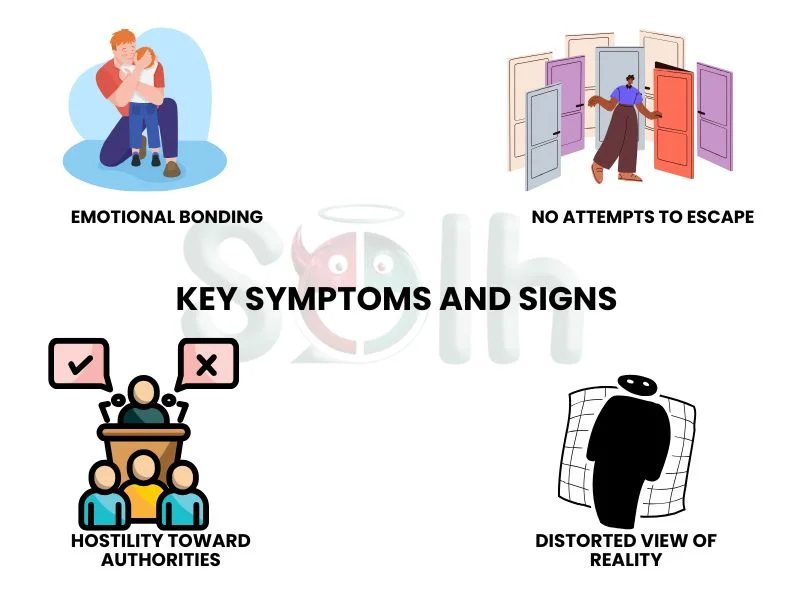“How can a victim develop affection for their captor?” This probably sounds paradoxical, but this opens the way to understanding one of the most mysterious psychological phenomena, Stockholm Syndrome. The term is also known as trauma bonding used to describe prisoners or victims of abuse who form positive feelings toward their captors or abusers.
The problem is survival and complications of the human mind under extreme pressure. We will enlighten the trauma bonding causes, psychology, and real-life examples to bring us closer to understanding the effects that traumatic circumstances have on a victim's emotional responses. Understanding this syndrome can help us to consider victims with more empathy and provide insight into their long-term recovery.
History & Origin of Stockholm Syndrome
Do you know about Stockholm Syndrome and why it is called that? The story began with a bank robbery in Stockholm, Sweden, in 1973. The scene started when two men took four bank employees prisoner during a failed heist. As negotiations with the police dragged on for days, something unexpected happened. Instead of getting more fearful or hostile toward their captors, the hostages began to empathize with them. They even defended their captors and feared the police more than the men holding them against their will.
After the incident, the term Stockholm Syndrome was coined by criminologists to describe the bond that formed between the prisoners and their captors. Psychologists and researchers started realizing this phenomenon as more than a curious abnormality. It became a subject of study, particularly in cases of long imprisonment or abusive relationships. Over the years, this Syndrome has represented the complex psychological dynamics of power, control, and survival.
The Psychology Behind Stockholm Syndrome
The human brain is wired for survival. It automatically responds with fight, flight, or freeze when life-threatening situations arise. However, in the context of extreme psychological strain and continuous exposure to violence, the psyche can develop an exciting coping mechanism, which is Stockholm Syndrome. This syndrome draws its roots from the attempt of the mind to reconcile two conflicting emotions: fear and dependence. Here, cognitive dissonance comes into play.
Victims tend to have mixed thoughts: the kidnapper is dangerous, but at the same time, the kidnapper provides for the needs of survival. And sometimes even doing small acts of kindness. This creates emotional turmoil, and victims tend to bond with their kidnappers as a way of dealing with their trauma.
Power dynamics further complicate the situation. There is no power on the victim's end; the captor has all the aces in this captivity game. The resulting power imbalance creates a distorted perception where such liberality is shown. For instance, feeding or permitting one to talk gets perceived as more of an act of kindness or protection. Eventually, the victim will tend to perceive the captor as more of a caregiver than an oppressor, cementing their emotional hold.
Key Symptoms and Signs
Identifying Stockholm Syndrome can be challenging, as victims may not even recognize their emotional shifts. However, several vital symptoms often signal the presence of the syndrome:

Emotional Bonding: Victims develop assertive, sometimes affectionate, feelings toward their captors. This can range from empathy to romantic attachment, even when their safety is at risk.
No Attempts to Escape: In situations where victims have opportunities to escape or receive outside help, they may refuse or resist. The fear of leaving their captor or feeling indebted to them can override the instinct for freedom.
Hostility Toward Authorities: Hates Towards the Rescuers: Some of the abducted victims had come to perceive the rescuer, the police, or family members as adversaries. They eventually defend the captor, whom they feel is underestimated or wrongly victimized.
Distorted View of Reality: Victims often fake more deficient harm than what has occurred with their captors. They explain their captors' actions and make themselves believe that things are not that bad for them.
There is also a reverse Stockholm Syndrome also known as Lima Syndrome in which an abuser or criminal forms a positive connection with their victim.
Cases of Stockholm Syndrome
One of the well-known cases of Stockholm Syndrome is the kidnapping of Patty Hearst. It happened in 1974. The Symbionese Liberation Army, a militant group, claimed the American heiress. During her imprisonment, Hearst developed empathy for her captors and even participated in a bank robbery with them. Her case became a textbook example of how a victim can begin to identify with their captors, even taking on their cause.
Another famous case is Jaycee Dugard, who was kidnapped at the age of 11 and imprisoned for 18 years by Phillip Garrido. Despite the terrible abuse she survived, Dugard developed a complicated relationship with her captor, raising his children and living in a state of confused dependence. While Dugard eventually escaped, her story shows the long-lasting psychological effects of prolonged captivity.
Other examples, like Elizabeth Smart & Natascha Kampusch, mainly show how victims of kidnapping can sometimes end up being emotional bindings with the kidnappers, which reflects the severe psychological effects of Stockholm Syndrome.
Causes & Contributing Factors
Several contributing factors influence the development of Stockholm Syndrome, each playing a vital role in misinterpreting the victim’s emotional response:
Isolation: When victims are isolated from the outside world, they have little choice but to depend on their captors for survival. This isolation can create a psychological bubble where the captor is the only source of human connection, making emotional bonds more likely.
Long-Term Exposure: Defining who is the captor and who is the captive becomes increasingly unclear during a long period of captivity. Such experiences blur the lines defining who the victim is, such that the victims may lose an identity of themselves through such shared experiences with their captors, no matter how abusive they are.
Small Acts of Kindness: In an attempt to contain their responses, the kidnappers also sometimes show them sympathy, like offering them food or discussing with them. At such small acts, in the mind of the victim, more importance is achieved because they are the initiators of emotional attachment and, at the same time, set up this distorted impression that the captor is not bad.
Psychological Impact
The impact of Stockholm Syndrome is not only physically damaging but emotionally complex. Victims often emerge from captivity with deep psychological wounds, which can manifest as trauma bonding. The emotional attachment to the abuser becomes so entangled with survival that victims may struggle to separate their feelings of gratitude from the abuse they endured.
Recovery is usually a long and challenging process, requiring professional therapy to address conditions like Post-Traumatic Stress Disorder , identity confusion, and difficulty trusting others. Therapy helps victims rebuild a sense of self-worth and regain control over their lives. Yet the scars of this Syndrome can last for years, affecting relationships, mental health, and self-perception.
Sometimes, the victims suffer guilt and shame as if it is their failing to have been able to develop feelings for the captors, wondering why they could not resist or run away. It's important to know that Stockholm Syndrome is not a failure of character but a survival strategy set out through circumstances.
Criticisms & Misconceptions
While Stockholm Syndrome has come to be recognized as a veritable psychological condition, it is not without its criticisms. Many argue that the term is overused or applied in inappropriate situations concerning the very level of captivity and abuse involved. For example, people might inaccurately use the term to describe a person involved in an unhealthy relationship, watering down the seriousness of the condition.
There is a gendered perspective as to how this syndrome gets interpreted. The women, for example, are primarily subjected to many critiques for having fallen into the arms of abusers, thus receiving judgments that make their recovery process tough and complicated. There needs to be a better insight into the concept of this Syndrome so that such misconceptions or misunderstandings are prevented, and a more compassionate approach toward the victims is ensured.
Conclusion
Stockholm syndrome is a very complicated psychological reaction that is more or less tied to our survival instincts and developed by trauma. Victims are not "choosing" to display affection toward their captors-they are merely a defense mechanism at extreme moments of fear and dependence. Understanding this syndrome allows one to declare feelings of empathy and sympathy toward those individuals who have experienced it but also points out the necessity for more specialized mental health programs to help victims heal from this trauma.
Solh understands. We offer a variety of features to help you invest in self-care.
Journaling for Self-Reflection: Sometimes, being unable to care for yourself can come from a lack of self-understanding. Solh's journaling feature allows you to explore your thoughts and feelings in a safe space. By reflecting on your experiences and desires, you can clarify what stops you from self-care.
Anonymous Support Groups: You are not alone. Solh's anonymous support groups connect you with others who understand the struggle. Share your experiences, find comfort in solidarity, and discover new perspectives on overcoming the hurdle to indulge in self-care.
Solh Buddy: Feeling lost or disconnected? Your Solh Buddy, a personalized virtual companion, is here to provide encouragement and support. It can offer prompts, celebrate your victories, and remind you of your strengths as you navigate the journey toward self-care.
Talk now: Sometimes, self-care can make you feel overwhelmed. Solh's Talk Now feature gives you access to dedicated counselors who can help you navigate such situations.
Solh believes in a unique approach to introducing self-care. We empower you to take charge of your well-being by offering a variety of tools. Explore Solh today and discover the power of self-reflection, connection, and support in overcoming any problem of the mind. You are not alone on this path.








